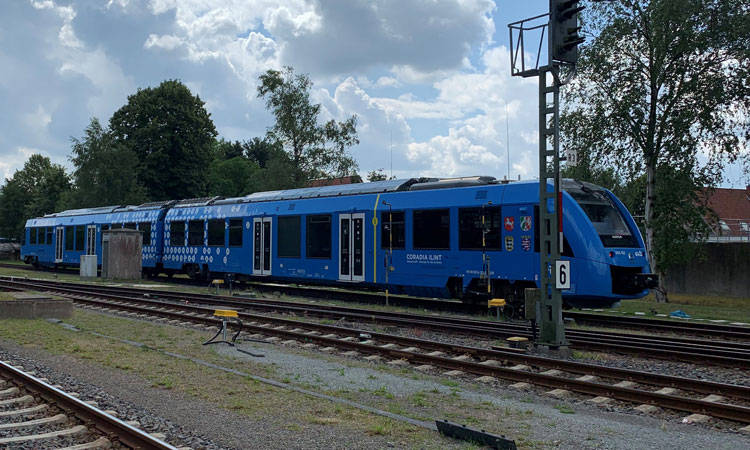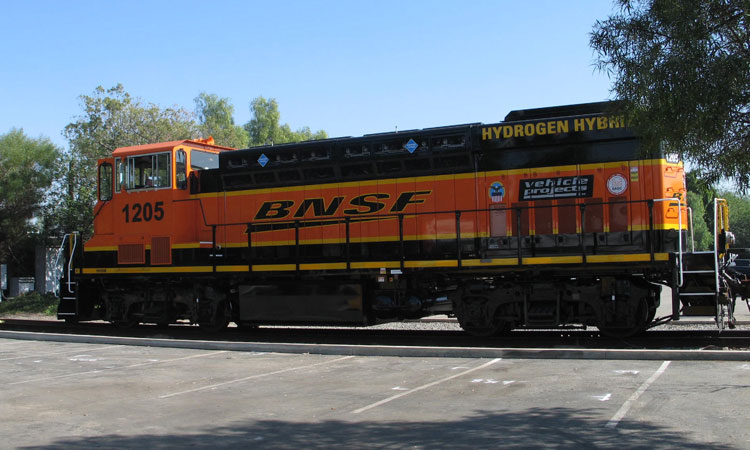Hydrogen-powered trains and their benefits in noise and vibration reduction
Posted: 28 November 2019 | Andreas Hoffrichter, Gord Lovegrove, Kerrick Lannon-Paakspuu, Mohamed A. Hegazi, Vishnu Kumar | No comments yet
Kerrick Lannon-Paakspuu (University of Toronto Mechanical Engineering Graduate), Dr. Gord Lovegrove (Professor, University of British Columbia), Vishnu Kumar (Engineer, University of British Columbia), Mohamed A. Hegazi (Researcher, University of British Columbia) and Dr. Andreas Hoffrichter (Professor, Michigan State University), explore the use of hydrogen as an environmentally friendly energy carrier for railway vehicle propulsion and its benefits in noise and vibration reduction.


Image 1 - The Coradia iLint hydrail passenger train which runs in northern Germany. Credit: Dr. Andreas Hoffrichter
Railways are amongst the most energy efficient and lowest emission-impact forms of transportation. Over the last few decades, the industry has reduced its air quality, impacting emissions significantly – with new locomotives achieving United States Environmental Protection Agency (US EPA) Tier 4 emission standards, whilst fuel consumption of modern locomotives has also reduced, with a direct impact on greenhouse gas emissions.
There are growing expectations among railroad companies and their shareholders towards zero-emissions in the U.S. and Canada. Many locomotives used across North America, including those used in switching and short line rail operations, are powered by outdated diesel-electric internal combustion engine (ICE) systems. For example, almost 72 per cent of Canada’s locomotive fleet is at US-EPA Tier 2 or lower for its emission levels, and 50 per cent are non-tier level locomotives1. Historically, complete electrification was employed to reduce emissions that result from fossil fuel combustion, but overhead wires and associated infrastructure (transmission lines, sub-stations, etc.) proved prohibitively costly to install and maintain2.
Hydrogen being proven worldwide
Hydrogen fuel cell/battery hybrid propulsion technology, otherwise known as hydrail, is being proven worldwide as an innovative electrification technology that completely eliminates emissions at the point of use (railway yards, terminals, etc.) aside from pure water. In addition to zero-emissions, hydrail power runs silently, a major improvement on the noise and vibration from their ICE diesel-electric counterparts. Several proof-of-concept and in-service hydrail systems have been demonstrated over the last 20 years, and it is gaining traction as an attractive and economically viable technology, especially for low-power, short-haul applications in the rail industry.
Hydrogen fuel cells used in the hydrail system convert chemical energy to electrical energy by combining hydrogen and oxygen – electricity, heat and water are the by-products. Performance of existing hydrail technology warrants their use in various industries; it is currently especially attractive for use in switching and passenger trains in the railway industry, with operating examples in Europe and China. While only emitting water during use, hydrail has been proven through life-cycle analysis to greatly reduce emissions and improve efficiencies over their lifetime when compared to diesel-electric on a well-to-wheel basis14,15.
Hydrail in service
Although in-service applications have been happening for some time in Europe, introduction to North America has been lagging despite multiple proof of concept projects3,4,5,16. In 2018, after over five years of field testing and design refinements by Alstom6, the Coradia iLint hydrail passenger train (Image 1) was put into service in northern Germany. It was a featured centrepiece of the 2019 International Hydrail Conference (IHC 2019). The project has had such success that another 60 trains have been ordered for service over the next five years. Alstom intends to demonstrate the iLint in North America in Spring 2021 and Russia has just recently launched a yard shunter/switching locomotive for its freight operations.
Hydrail for the North American markets
Researchers across North America have been developing similar hydrail technology for the North American markets. At the University of British-Columbia, Okanagan Campus, led by Dr. Gordon Lovegrove, an Okanagan Valley Electric Regional Passenger Rail (OVER PR) is being designed as a hydrogen fuel cell powered (hydrail) regional passenger train connecting small and rural communities, over 300km, between the U.S. border and Kamloops. Preliminary estimates of societal noise reduction benefits have been projected at $12 million annually in this small region13. Extrapolated across North America, benefits in the range of $24 billion annually could be expected if hydrail power systems were adopted for passenger and freight rail.
Simple retrofitting of outdated diesel-electric locomotives is also possible and has been demonstrated as a cost-effective method to convert existing passenger trains7. Moreover, rail yard switcher locomotives in North America have a disproportionate impact on air quality and health risks in the surrounding communities due to high concentrations of diesel particulates and nitrogen oxides8. They account for only three per cent of the total number of diesel locomotives in the North American fleet, but account for over five per cent of all rail emissions. The North American rail industry has considered hydrail for yard switchers with a successful proof-of-concept locomotive tested at the BNSF Los Angeles Metro area back in 2009-2010 (Image 2)9. While having the major benefit of zero-emissions, this locomotive had an extremely positive response from train engineers due to their lack of diesel noise, vibration, and exhaust. Local communities would undoubtedly benefit as well. However, challenges including economic viability of the technology had to be addressed. Ten years later, current generation hydrail technology has overcome its original shortcomings, such that the economics now make more sense in some applications.


Image 2 – Hydrogen hybrid switch locomotive tested at the BNSF railyard in the LA Metro area. Credit: Dr. Andreas Hoffrichter
Noise and vibrations
The urban/rural freight rail interface has always been an item of concern for local residents. Locals living next to train tracks often complain about the level and frequency of noise, emissions, and vibrations from passing locomotives. The industry has traditionally responded through the construction of costly noise protection infrastructure and reducing diesel engine size, both of which have economic and/or productivity impacts on the rail industry. Reducing locomotive noise continues to be a subject of research. The two greatest sources of noise from diesel-powered locomotives are from the engine exhaust and cooling fan10. Without an engine, hydrail locomotives inherently remove the most significant sources of noise that diesel engines emit.
Train engineers will also benefit from hydrail locomotives. Increased level of comfort due to the lack of diesel exhaust, engine noise, and vibration will lead to reduced chronic illness and injury, and increased productivity from reduced sick days taken. With lower noise levels, potential hearing loss risks will also be reduced. For the same reasons, other employees working in rail yards will also benefit if the switch from locomotive to hydrail becomes the standard.
The railway industry is often correlated with negative health benefits due to air and noise pollution, as well as vibrations caused. V. Kyrlov’s research from Nottingham Trent University11 states that higher speed trains can cause over 70dB higher vibration levels than trains running at 50km/h. This measure can drastically differ with soil attenuation value. Even at lower speeds, trains running over soil with low attenuation (γ=0.005) can cause a vibration level as high as 140dB, which is equivalent to a vibration velocity of 10mm/s. Many freight trains are operated at night. These acute vibrations could severely affect the sleep quality and health conditions of the community living near the tracks. Research conducted by the University of Gothenburg in Sweden on the health impacts of train vibrations12 found that there was no sleep disturbance with a vibration amplitude of less than 0.4mm/sec. However, sleep disturbance steadily increased with vibration amplitude, leading to difficulty falling asleep and increased tiredness within the experimental group. In addition to sleep-cycle disturbance, the experiment also reported similar results regarding heart rates, in that they also increased with an increase in vibration amplitude. This can have adverse effects on heart health in humans. Hydrail trains could be part of the solution to these issues, as it is operated by a fuel cell which creates no noise and vibration from power generation.
Summary
Hydrogen fuel cells in general have long been proposed as a solution to achieve emission reduction policy goals, aiming to improve air quality while reducing greenhouse gases to lower the impact of climate change. Recent hydrail proof-of-concepts and in-service projects have successfully demonstrated that this technology works for lower power applications such as regional passenger trains and yard switcher locomotives. In addition to the advantage of zero-emissions, improving air quality, and helping address climate change, hydrail motive power vehicles do not emit ICE noise nor vibrations, which is another major problem of diesel engines, especially in urban areas. Hydrail can also help address issues with noise and vibrations, leading to improvements for rail employees and communities near rail yards and lines. As we move towards a cleaner energy future, hydrogen fuel cells offer a zero-emissions alternative at significantly reduced noise and vibration levels. The first hydrail prototype is planned to be demonstrated at the International Hydrail Conference in Kelowna, 1-5 June 2020.


KERRICK LANNON-PAAKSPUU received his Bachelor of Applied Science in Mechanical Engineering at the University of Toronto in 2018, where he studied sustainable energy sources. In 2017 and 2018, Kerrick was part of a team that designed and prototyped an energy harvesting floor-tile. He is currently pursuing his Master of Engineering at UBC Okanagan in pursuit of his passion for sustainable technologies.


DR. GORD LOVEGROVE is an expert in sustainable civil engineering, which stems from over 30 years of hands-on experience and innovative, rigorous science-based research. While leading a research team at UBC Okanagan, Gord is also Vice President of Technical Programs for the Canadian Society for Civil Engineers (CSCE). Gord hopes to improve sustainability in communities and in the transportation industry, which he is doing through his many research projects such as OVER PR, SMARTer Growth Neighbourhoods, and ComPASS.


MOHAMED A. HEGAZI is a UBC researcher and an expert in locomotive powertrain design, instrumentation, and data collection. He is the technical lead at UBC’s Sustainable Transport Safety Lab, currently pursuing a PhD degree focusing on hydrail retrofits. He has presented his work at multiple events such as the AREMA, Hydrail, and CSME annual conferences. Mohamed seeks to revolutionise the railway sector through the integration of modern Internet of Things (IoT) and data analytics. Currently, Mohamed is working on Canada’s first hydrail low-power prototype vehicle set to be completed in 2020.




References:
- Gullo, M, ‘Locomotive Emissions Monitoring Program’, Railway Association of Canada, 2016.
- G. Smith, I. Croy and K. P. Waye, ‘On the Influence of Freight Trains on Humans: A Laboratory Investigation of the Impact of Nocturnal Low Frequency Vibration and Noise on Sleep and Heart Rate’, Plos One, vol. 8, no. 2, 2013.
- Hoffrichter, J. Silmon, F. Schmid, S. Hillmansen and C. & Roberts, ‘Feasibility of discontinuous electrification on the Great Western Main Line determined by train simulation’, Proceedings of the Institution of Mechanical Engineers, Part F: Journal of Rail and Rapid Transit, vol. 227, no. 3, pp. 296-306, 2013.
- R. Akli, X. Roboam, B. Sareni and A. Jeunesse, ‘Energy management and sizing of a hybrid locomotive’, in European conference on power electronics and applications, 2007.
- R. Miller, ‘Tunneling and mining applications of fuel cell vehicles’, Fuel Cells Bulletin, vol. 3, no. 22, pp. 5-9, 2000.
- ‘Alstom Coradia iLint’. [Online]. Available: alstom.com/our-solutions/rolling-stock/coradia-ilint-worlds-1st-hydrogen-powered-train
- Hegazi, Lovegrove, Markley, ‘Influence of battery sizing on fuel cell efficiency and hydrogen consumption in fuel cell/battery hybrid powertrains for retrofitted multiple units: The case of British Class 15x’, School of Engineering, University of British Columbia, Kelowna, Canada, 2015.
- ‘Hydrogen Powered Trains: The Next Generation of Shunters?’ [Online]. Available: https://blog.ballard.com/hydrogen-powered-trains.
- S. Hess, A. R. Miller, T. L. Erickson, and J. L. Dippo, ‘Demonstration of a Hydrogen Fuel-Cell Locomotive’, In proc. Locomotive Maintenance Officers Association conference, Chicago, 2008.
- Tiwari, ‘Diesel Locomotive Noise Sources, Reduction Strategies, Methods and Standards’, in Locomotives and Rail Road Transportation: Technology, Challenges and Prospects, A. K. Agarwal, A. Dhar, A. Gautam, and A. Pandey, Eds. Singapore: Springer, 2017, pp. 41–69.
- Krylov, ‘Effects of Track Properties on Ground Vibrations Generated by High-Speed Trains’, ACUSTICA , vol. 84, pp. 78-90, 1998.
- Boozarjomehri, E. Morrison, I. Roth and G. Lovegrove, ‘Moving Away From Diesel and Towards All-Electric Locomotives in North America: Planning and Logistics of Ultra-Capacitor/Battery Technology’, in Joint Rail Conference, Philadelphia, 2012.
- Md Firoz Mahmood Ovi & Askhay Dhawan, ‘Business Case Study for Okanagan Valley Electric Regional Passenger Rail (OVER PR)’, School of Engineering, University of British Columbia Okanagan, Kelowna, April 2019.
- Hoffrichter, A.R. Miller, S. Hillmansen, and C. Roberts, ‘Well-to-wheel analysis for electric, diesel and hydrogen traction for railways’, Transportation Research Part D, vol. 17, pp. 28-34, 2012.
- Hoffrichter, S. Hillmansen, and C. Roberts, ‘Conceptual propulsion system design for a hydrogen-powered regional train’, IET Electrical Systems in Transportation, vol. 6, iss. 2, pp. 56-66, 2016.
- Hoffrichter, P. Fisher, J. Tutcher, S. Hillmansen, and C. Roberts, ‘Performance evaluation of the hydrogen-powered prototype locomotive ‘Hydrogen Pioneer’, Journal of Power Sources, vol. 250, pp. 120-127, 2014.
Issue
Related topics
Rolling Stock Orders/Developments, Sustainability/Decarbonisation







